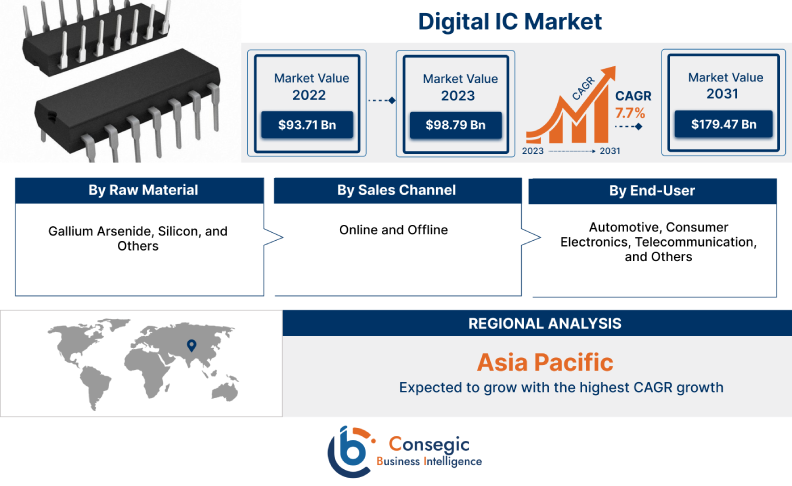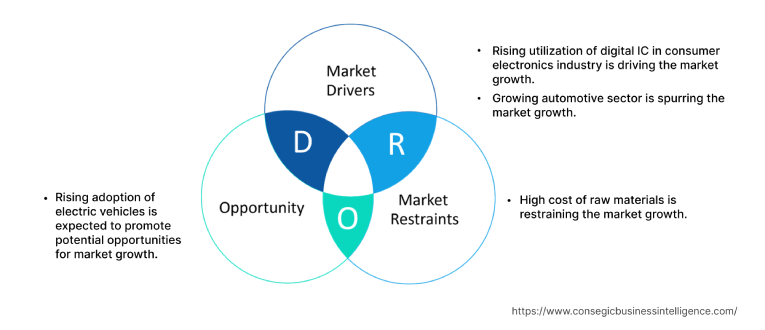Digital IC Market Size :
Digital IC Market size is estimated to reach over USD 207.34 Billion by 2032 from a value of USD 106.35 Billion in 2024 and is projected to grow by USD 114.75 Billion in 2025, growing at a CAGR of 7.70% from 2025 to 2032.
Digital IC Market Scope & Overview:
A digital IC (integrated circuit) refers to any semiconductor-based chip that consists of an integrated set of digital circuitry. Digital ICs usually handle discrete signals such as binary values (0 and 1) and play a crucial role in functioning of electronics. Moreover, digital ICs offer a range of benefits including low power consumption, extremely small size, lightweight, lower cost, high reliability, and ease of replacement among others. The aforementioned benefits of digital ICs are major determinants for increasing its deployment in automotive, telecommunication, consumer electronics, and other industries.
Digital IC Market Insights :
Digital IC Market Dynamics - (DRO) :
Key Drivers :
Rising utilization of digital IC in consumer electronics industry is driving the market growth
Digital ICs are primarily utilized in the consumer electronics industry for application in smartphones, laptops, tablets, and other consumer devices. Digital ICs are responsible for processing and storing data, providing connectivity, and managing power consumption in consumer electronics devices. Moreover, the characteristics of digital ICs including low power consumption, small size, fast processing speed, and high reliability are key prospects increasing its utilization in the consumer electronics sector.
Factors including growing penetration of laptops, smartphones, and other consumer devices, progressions in consumer electronics, and rising demand for energy-efficient devices are primary aspects fostering the growth of the consumer electronics sector.
According to Japan Electronics and Information Technology, the overall production value of Japanese electronics industry reached USD 95.2 billion in 2021, depicting a growth of approximately 10% as compared to 2020. Furthermore, according to the Association of German Banks, the manufacturing and sales of electronics sector in Germany observed a significant growth of 10% in 2021 in comparison to 2020.
Therefore, the growth of consumer electronics sector is driving the integration of digital ICs in smartphones, laptops, and other consumer devices, in turn boosting the digital IC market trends.
Growing automotive sector is spurring the market growth
Digital ICs are utilized in the automotive sector, particularly in automobile electronics systems. Digital ICs are used in several components of automobiles including transmission control system, vehicle airbags, advanced driver assistance system (ADAS), engine management, in-vehicle communication and alternator electronics among others.
Factors including rising automotive production, increasing investments in automobile manufacturing facilities, advancement in autonomous driving, and growing adoption of electric vehicles are among the vital aspects driving the growth of the automotive sector.
For instance, according to the International Organization of Motor Vehicle Manufacturers, the production of passenger cars across the world reached 61.59 million in 2022, representing an increase of around 8% as compared to 57.05 million in 2021.
Meanwhile, according to the European Automobile Manufacturers Association, the production of passenger cars in European Union reached up to 10.9 million in 2022, demonstrating an incline of 8.3% in contrast to 2021. Hence, the rise in automobile production is driving the adoption of digital ICs for application in automobile electronics systems, in turn driving the growth of the market.
Key Restraints :
High Cost of Raw Materials Hindering Digital IC Market Growth
The escalating cost of essential raw materials, such as silicon, gallium arsenide, and others, is emerging as a significant challenge for the digital IC market. These materials are critical for manufacturing high-performance digital ICs, but their steep prices are creating cost pressures that hinder the growth and competitiveness of the market.
For instance, according to ChemicalBook, the average cost of gallium arsenide with 99.99% assay is around USD 2,334 for 50 grams, which is relatively very high. Additionally, the average silicon export price in the United States was valued at USD 34,224 per ton in 2022, witnessing an incline of 58% as compared to the previous year.
Therefore, the high costs of raw materials utilized in the manufacturing of digital ICs are restraining the growth of the market.
Future Opportunities :
Rising adoption of electric vehicles is expected to promote potential opportunities for market growth
The rising adoption of electric vehicles is expected to present potential opportunities for the growth of the digital IC market. Digital ICs are often used in several EV components including advanced driver assistance system (ADAS), ignition controllers and drivers, battery management system, and other related components.
Factors including the advances in electro mobility, accessibility to broad range of models, eco-friendliness, and prevalence of subsidies and tax rebates are driving the adoption of electric vehicles.
For instance, the government of India has launched several initiatives including FAME-II Initiatives, PLI Scheme, and duty reduction on electric vehicles to promote the adoption of EVs in the country.
Additionally, according to the International Energy Agency (IEA), the global sales of electric cars observed a substantial growth in 2022. According to IEA, the global sales of electric vehicles reached up to 2 million units during the first quarter of 2022, witnessing a growth of 75% in contrast to the first quarter of 2021.
Hence, the rising adoption of electric vehicles is anticipated to increase the utilization of digital IC for application in EV electronic systems, in turn promoting digital IC market opportunities for during the forecast period.
Digital IC Market Report Insights :
| Report Attributes | Report Details |
| Study Timeline | 2019-2032 |
| Market Size in 2032 | USD 207.34 Billion |
| CAGR (2025-2032) | 7.7% |
| By Raw Material | Gallium Arsenide, Silicon, and Others |
| By Sales Channel | Online and Offline |
| By End-User | Automotive, Consumer Electronics, Telecommunication, and Others |
| By Region | North America, Europe, Asia-Pacific, Latin America, and Middle East & Africa |
| Key Players | Texas Instruments Incorporated, Broadcom, Infineon Technologies AG, Lattice Semiconductor, Taiwan Semiconductor Manufacturing Company, Renesas Electronics Corporation, Toshiba Corporation, Analog Devices Inc., Qualcomm Technologies Inc., Intel Corporation |
| Geographies Covered | |
| North America | U.S. Canada Mexico |
| Europe | U.K. Germany France Spain Italy Russia Benelux Rest of Europe |
| APAC | China South Korea Japan India Australia ASEAN Rest of Asia-Pacific |
| Middle East and Africa | GCC Turkey South Africa Rest of MEA |
| LATAM | Brazil Argentina Chile Rest of LATAM |
| Report Coverage | Revenue Forecast, Competitive Landscape, Growth Factors, Restraint or Challenges, Opportunities, Environment & Regulatory Landscape, PESTLE Analysis, PORTER Analysis, Key Technology Landscape, Value Chain Analysis, Cost Analysis, and Regional Trends & Forecast |
Digital IC Market Segmental Analysis :
By Raw Material :
Based on the raw material, the market is segmented into gallium arsenide, silicon, and others. The silicon segment accounted for the largest revenue digital IC market share in the year 2024. Silicon is among the primary materials used in production of digital ICs. Moreover, silicon offers excellent insulation between several components, which enables fabrication of densely packed and complex ICs. Additionally, silicon offers several other benefits including high thermal conductivity, minimized warpage, while supporting miniaturization for advanced IC packaging for compact electronic devices. The aforementioned benefits of silicon material are driving its utilization in digital ICs.
In October 2023, the Ministry of Electronics and Information Technology of India launched Silicon Photonics Research Centre of Excellence at Indian Institute of Technology Madras. The center aims at facilitating silicon-based integrated circuit manufacturing in India. Thus, rising advancements associated with silicon-based integrated circuits is among the prime factors driving the growth of the segment.
The gallium arsenide segment is anticipated to register fastest CAGR growth during the forecast period. Gallium arsenide is a direct band gap semiconductor integrated with a zinc blend crystal structure and is often used in manufacturing of integrated circuits. Moreover, gallium arsenide provides a range of benefits including high flexibility, lightweight, higher efficiency, and greater resistance to moisture and radiation, which are primary determinants for increasing its utilization in digital ICs.
In November 2021, researchers at Princeton University developed a very pure sample of gallium arsenide, paving the way for further exploration of quantum phenomena. Therefore, the rising research and development activities related to gallium arsenide is anticipated to boost the growth of the segment during the forecast period.
By Sales Channel :
Based on the sales channel, the market is segregated into online and offline. The offline segment accounted for the largest revenue share in the year 2024.
Offline sales channel includes the distribution of digital ICs from manufacturers to the end-users indirectly through offline distributors such as specialty stores, regional distributors, and others. Moreover, the growth of the offline segment is primarily driven by several factors including the including higher credibility, ease of customization as per the target market, and strong customer base among others.
For instance, Broadcom is a manufacturer of digital IC that offers a range of digital ICs through various offline regional distributors including DigiKey, Mouser Electronics Inc., and others. Hence, the increasing availability of digital ICs in offline sales channel is anticipated to boost the growth of the market during the forecast period.
Online segment is expected to witness the fastest CAGR growth during the forecast period. Online sales channel provides a mode of distribution in which the manufacturers sell products through the company websites or any other third-party e-commerce websites that are available on the internet. Online distribution channels offer several benefits such as easy access to the products, faster buying process, quicker comparison of multiple products and prices, and higher flexibility among others. The aforementioned benefits of online sales channels are key determinants for driving its utilization for the distribution of digital ICs.
For instance, Texas Instruments Incorporated is among the few digital IC manufacturers that provide a range of digital ICs for online purchase through the company website along with multiple e-commerce websites including eBay, Indiamart, and others. Hence, the increasing availability of digital ICs in online sales channels is a prime factor driving the growth of the market.
By End-User :
Based on the end-user, the market is segregated into automotive, telecommunication, consumer electronics, and others. The consumer electronics segment accounted for the largest revenue share of 32.81% in the year 2024. Factors including growing penetration of laptops, smartphones, and other consumer devices, progressions in consumer electronics, and rising demand for energy-efficient devices are driving the growth of the consumer electronics segment.
According to the Brazilian Electrical and Electronics Industry Association (ABINEE), the value of electrical and electronics sector in Brazil reached USD 42.2 billion in 2022, demonstrating a growth of approximately 8% as compared to USD 39.2 billion in 2021. Digital ICs are responsible for processing and storing data, providing connectivity, and managing power consumption in consumer electronics devices. Therefore, the growth of consumer electronics industry is driving the adoption of digital IC for its application in smartphones, laptops, and other consumer devices, in turn fostering the growth of the market.
Automotive segment is expected to witness the fastest CAGR growth during the forecast period. The growth of automotive segment is primarily driven by multiple factors including increasing automotive production, growing investments in automobile manufacturing facilities, advancement in autonomous driving, and rising adoption of electric vehicles among others.
For instance, according to the China Association of Automobile Manufacturers, the overall manufacturing of passenger cars in China reached 14.8 million units in January-August 2022, demonstrating a YoY growth of 14.7%. Digital ICs are utilized in the automotive sector, particularly in automobile electronics systems including transmission control system, advanced driver assistance system (ADAS), engine management, in-vehicle communication and alternator electronics among others. Thus, the rising production from automotive sector is projected to drive the market growth during the forecast period.
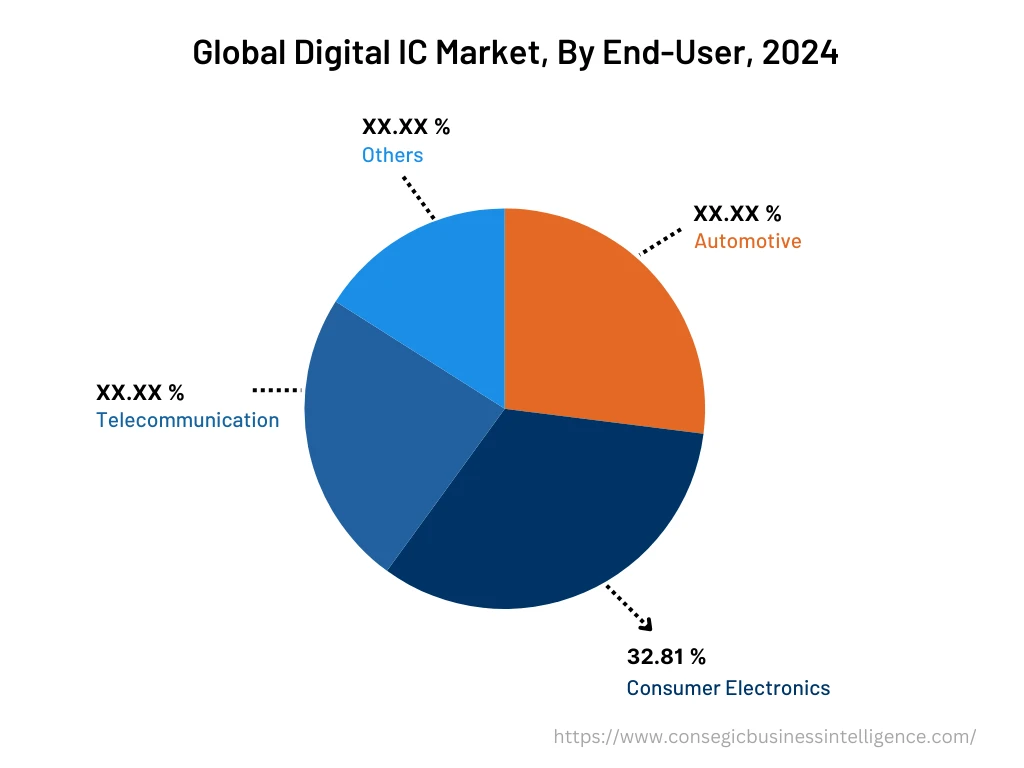
By Region :
The regional segment includes North America, Europe, Asia Pacific, Middle East and Africa, and Latin America.
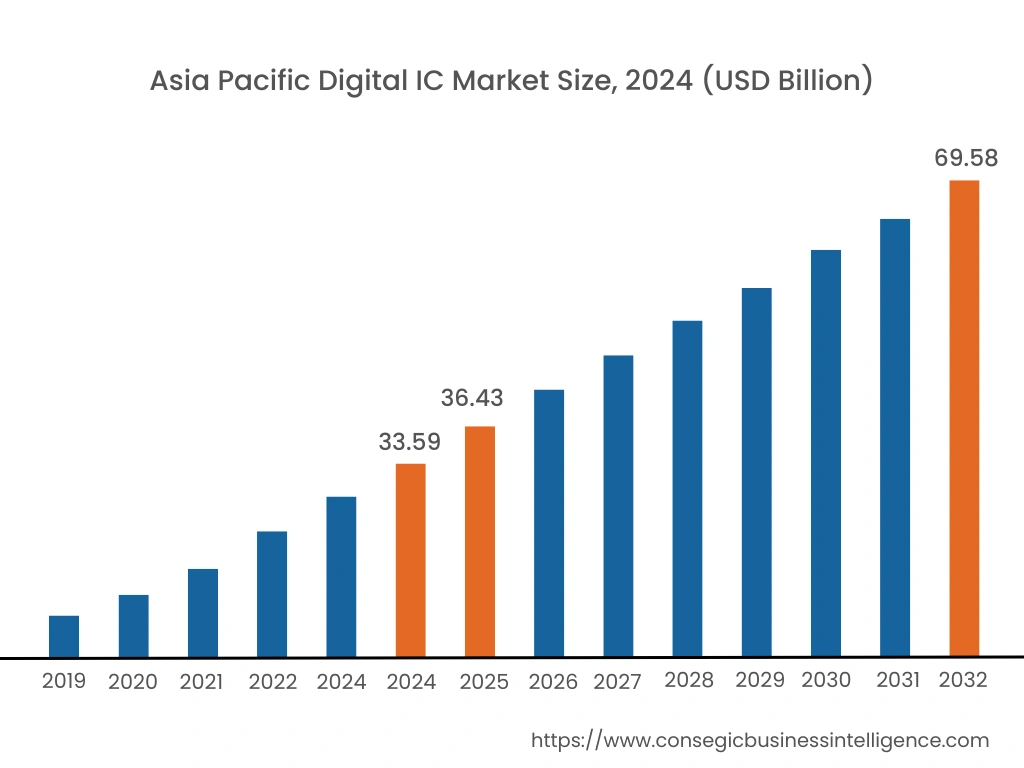
North America is estimated to reach over USD 47.92 Billion by 2032 from a value of USD 24.88 Billion in 2024 and is projected to grow by USD 26.82 Billion in 2025.
The market growth for digital IC in the North American region is mainly driven by its deployment in automotive, telecommunication, and other industries. Moreover, the rising integration of digital ICs in multiple automobile components including transmission control system, vehicle airbags, advanced driver assistance system (ADAS), engine management, in-vehicle communication and alternator electronics has been a prevalent factor for market growth in the region.
For instance, according to the International Organization of Motor Vehicle Manufacturers, the overall automotive production in North America reached 14.79 million in 2022, witnessing a growth of nearly 10% from 13.46 million in 2021. The above factors are stimulating market growth in North America. Furthermore, factors including increasing investments in the field of electric vehicles and 5G infrastructure are projected to drive the market growth in North America during the forecast period.
Asia-Pacific is expected to grow with the highest CAGR growth of 8.40%. In addition, in the region, the China accounted for the maximum revenue share of 35.70% in the same year.
The growing pace of industrialization and development is providing lucrative growth prospects for the market in the region. In addition, factors including the growth of various industries including consumer electronics, telecommunication, and others are driving the market growth for digital IC in the Asia-Pacific region.
For instance, according to the India Brand Equity Foundation, the consumer electronics industry in India was valued at USD 9.84 billion in 2021, and it is anticipated to grow at a substantial rate to reach USD 21.18 billion by 2025. Therefore, the growing consumer electronics sector is driving the deployment of digital ICs for application in laptops, smartphones, and consumer appliances, thereby boosting the market growth in the Asia-Pacific region.
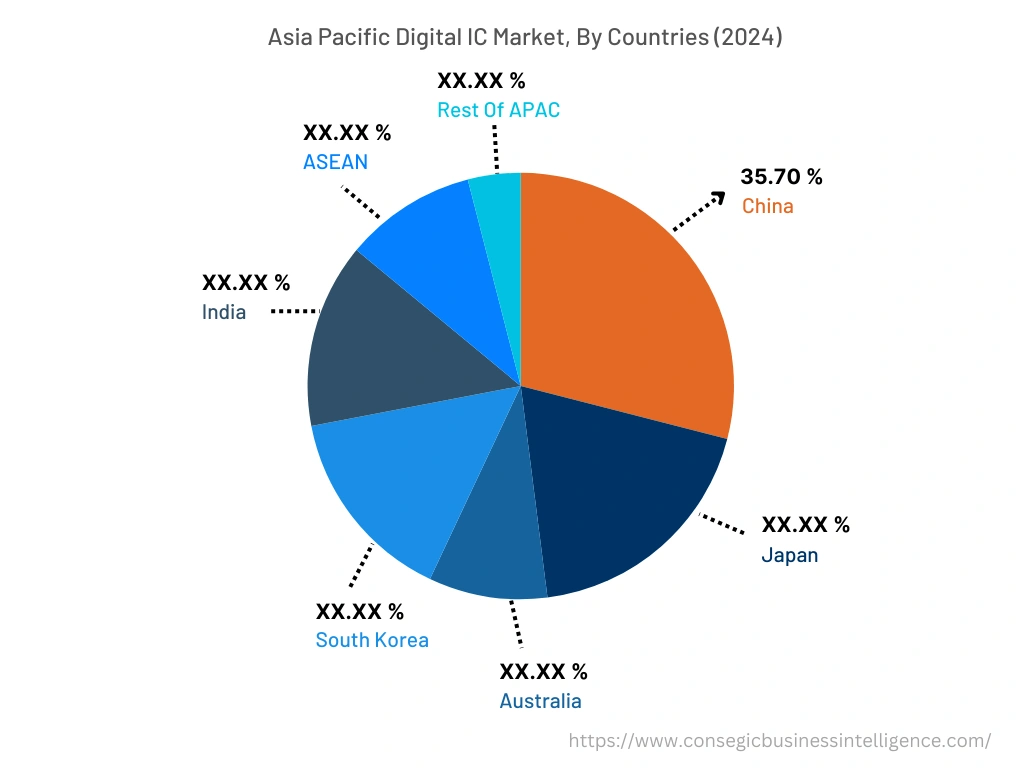
Top Key Players & Market Share Insights:
The digital IC market is highly competitive with major players providing digital IC to the national and international markets. Key players are adopting several strategies in research and development (R&D), product innovation, and end-user launches to hold a strong position in digital IC market. Key players in the digital IC market include-
- Texas Instruments Incorporated
- Broadcom
- Analog Devices Inc.
- Qualcomm Technologies Inc.
- Intel Corporation
- Infineon Technologies AG
- Lattice Semiconductor
- Taiwan Semiconductor Manufacturing Company
- Renesas Electronics Corporation
- Toshiba Corporation
Recent Industry Developments :
- In August 2022, Pandora launched their new collection with lab-created diamonds and 100% recycled silver and gold.
- In December 2021, Harry Winston, Inc. announced the opening of their new retail salon in Milan, Italy.
Key Questions Answered in the Report
What is digital IC? +
A digital IC (integrated circuit) refers to any semiconductor-based chip that consist of an integrated set of digital circuitry.
What specific segmentation details are covered in the digital IC report, and how is the dominating segment impacting the market growth? +
For instance, by raw material segment has witnessed silicon as the dominating segment in the year 2024, owing to the increasing adoption of silicon-based ICs in consumer electronics, telecommunication, and other industrial applications.
What specific segmentation details are covered in the digital IC market report, and how is the fastest segment anticipated to impact the market growth? +
For instance, by end-user segment has witnessed automotive as the fastest-growing segment during the forecast period due to rising adoption of digital ICs in automobile electronics system including infotainment system, ADAS, battery management system, and others.
Which region/country is anticipated to witness the highest CAGR during the forecast period, 2025-2032? +
Asia-Pacific is anticipated to register fastest CAGR growth during the forecast period due to rapid pace of industrialization and growth of multiple industries such as consumer electronics, telecommunication, and others.
